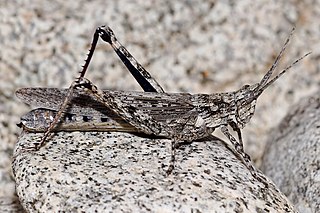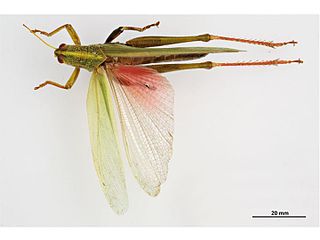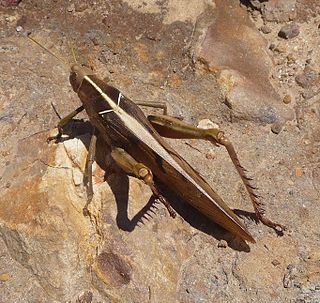
Acrididae, commonly called short-horned grasshoppers, are the predominant family of grasshoppers, comprising some 10,000 of the 11,000 species of the entire suborder Caelifera. The Acrididae are best known because all locusts are of the Acrididae. The subfamily Oedipodinae is sometimes classified as a distinct family Oedipodidae in the superfamily Acridoidea. Acrididae grasshoppers are characterized by relatively short and stout antennae, and tympana on the side of the first abdominal segment.

Bandwings, or band-winged grasshoppers, are the subfamily Oedipodinae of grasshoppers classified under the family Acrididae. They have a worldwide distribution and were originally elevated to full family status as the Oedipodidae. Many species primarily inhabit xeric weedy fields, and some are considered to be important locusts:

The grasshopper subfamily Acridinae, sometimes called silent slant-faced grasshoppers, belong of the large family Acrididae in the Orthoptera: Caelifera.

The red locust is a large grasshopper species found in sub-Saharan Africa. Its name refers to the colour of its hind wings. It is sometimes called the criquet nomade in French, due to its nomadic movements in the dry season. When it forms swarms, it is described as a locust.

Acridini is a tribe of insects in the subfamily Acridinae, of the insect family Acrididae and are sometimes called "silent slant-faced grasshoppers". It was firstly described as Truxalis Conicus in 1781

Aiolopus is a genus of grasshopper belonging to the family Acrididae, subfamily Oedipodinae and tribe Epacromiini. Species can be found in Africa, Europe and Asia - through to New Caledonia.

Anacridium moestum, the camouflaged tree locust, is a species of grasshopper belonging to the family Acrididae, that is native to Africa south of the equator. It is similar in appearance to the Southern African desert locust, Schistocerca gregaria flavicentris. It is likewise brownish, large and slender, but mostly arboreal in its habits.

Anacridium is a genus of "tree locusts" or "bird grasshoppers" belonging to the subfamily Cyrtacanthacridinae.

The Cyrtacanthacridinae are a subfamily of Orthoptera: Caelifera in the family Acrididae. They are sometimes referred-to as bird locusts, criquets voyageurs in French-speaking Africa, and Knarrschrecken in German.

Patanga is a genus of grasshoppers in the subfamily Cyrtacanthacridinae. Species are distributed throughout Asia: from India, China, Japan, Indochina and western Malesia. The genus was named by Boris Uvarov in 1923, with the type species the economically significant Bombay locust: which has also been placed in genus Nomadacris.

Poekilocerus is a genus of grasshoppers in the family Pyrgomorphidae and the monotypic tribe Poekilocerini. Species are found in the northern half of Africa, and in Southwest and South Asia, often in arid or semi-arid areas.
Aztecacris is a genus of spur-throated grasshoppers in the family Acrididae. There are three described species in Aztecacris.

Chondracris is a genus of grasshoppers in the subfamily Cyrtacanthacridinae. Species records are distributed throughout Asia: from India, southern China, Korea, Japan, Indo-China and Java.

Schistocerca pallens is a large “bird grasshopper” in the subfamily Cyrtacanthacridinae that occurs throughout tropical America. It is closely related to Schistocerca cancellata but shows no swarming behaviour or locust phase polymorphism, even under crowded laboratory conditions. Although not a swarming locust, it can occur at sufficiently high densities to cause economic damage. It is mainly a pest of sugar cane, but has also been recorded as damaging almond, banana, beans, breadfruit, carnauba wax palm, chickpeas, coconut palms, cotton, forage crops, groundnuts, indigo, legumes, maize, onions, rice, sorghum, sweet potato and tomatoes.
Ritchiella is a genus of grasshoppers in the subfamily Cyrtacanthacridinae with species found in Africa.
Blaesoxipha is a genus of flies belonging to the family Sarcophagidae.

Acanthacris ruficornis is a species of bird grasshopper in the family Acrididae. It is found in Africa and southern Europe.
Oxytauchira is a genus of grasshoppers (Acrididae) in the subfamily Oxyinae. The known distribution of species is: India, southern China, Indochina, Java and Sulawesi.
The Euryphyminae are a subfamily of grasshoppers in the family Acrididae, based on the type genus Euryphymus and may be called "agile grasshoppers"; it was erected by Vitaly Michailovitsh Dirsh in 1956. Species have been recorded from parts of sub-Saharan Africa including Madagascar.

Cyrtacanthacris aeruginosa or simply, green tree locust, is a large species of grasshopper that can be found in the grasslands of Africa. They pertain to the genus Cyrtacanthacris and are composed by three subspecies, C. a. aeruginosa, C. a. flavescens and C. a. goldingi, all three of them are monophyletic. The specie is univoltine, that is, it only produces one brood of offspring per year, furthermore it also experiences egg diapause, meaning that the eggs have a phase of suspended or arrested growth. In terms of overwintering strategy, Aeruginosa adults mate and then the female lay the eggs and die before the dry season, the eggs stay in diapause for 7 months and take 45–67 days to incubate.

















